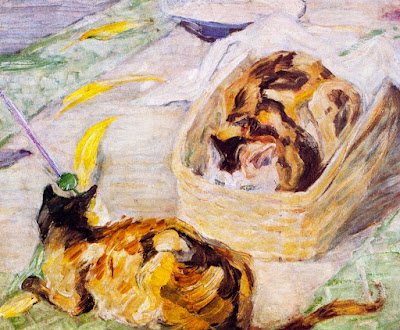of the dog called the setter
John Caius wrote the first book on English dogs in 1576 (we've seen him before, writing of terriers). Here he speaks of a breed we love well here at the Museum, for as longtime readers know, the "staff" includes Briar, the English Setter. I have left it in the original English of the time, so sometimes you'll see a "v" is used for "u" and vice versa, as in "vpon" (upon) and "indeuour" (endeavor).
* * *
Another sort of Dogges be there, seruiceable for fowling, making no noise either with foote or with tounge, whiles they followe the game. These attend diligently vpon theyr Master and frame their conditions to such beckes, motions, and gestures, as it shall please him to exhibite and make, either going forward, drawing backeward, inclining to the right hand, or yealding toward the left, (In making mencion of fowles my meaning is of the Partridge and the Quaile) when he hath founde the byrde, he keepeth sure and fast silence, he stayeth his steppes and wil proceede no further, and with a close, couert, watching eye, layeth his belly to the grounde and so creepeth forward like a worme. When he approcheth neere to the place where the birde is, he layes him downe, and with a marcke of his pawes, betrayeth the place of the byrdes last abode, whereby it is supposed that this kinde of dogge is called Index, Setter, being in deede a name most consonant and agreable to his quality. The place being knowne by the meanes of the dogge, the fowler immediatly openeth and spreadeth his net, intending to take them, which being done the dogge at the accustomed becke or vsuall signe of his Master ryseth vp by and by, and draweth neerer to the fowle that by his presence they might be the authors of their owne insnaring, and be ready intangled in the prepared net. . .
-- Caius, John, 1510-1573. Of Englishe Dogges, the Diversities, the Names, the Natures And the Properties: a Short Treatise Written In Latine And Newly Drawne Into Englishe. [Washington: Reprinted from the original by M. G. Denlinger, 1945. pp. 15-16.
* * *
Another sort of Dogges be there, seruiceable for fowling, making no noise either with foote or with tounge, whiles they followe the game. These attend diligently vpon theyr Master and frame their conditions to such beckes, motions, and gestures, as it shall please him to exhibite and make, either going forward, drawing backeward, inclining to the right hand, or yealding toward the left, (In making mencion of fowles my meaning is of the Partridge and the Quaile) when he hath founde the byrde, he keepeth sure and fast silence, he stayeth his steppes and wil proceede no further, and with a close, couert, watching eye, layeth his belly to the grounde and so creepeth forward like a worme. When he approcheth neere to the place where the birde is, he layes him downe, and with a marcke of his pawes, betrayeth the place of the byrdes last abode, whereby it is supposed that this kinde of dogge is called Index, Setter, being in deede a name most consonant and agreable to his quality. The place being knowne by the meanes of the dogge, the fowler immediatly openeth and spreadeth his net, intending to take them, which being done the dogge at the accustomed becke or vsuall signe of his Master ryseth vp by and by, and draweth neerer to the fowle that by his presence they might be the authors of their owne insnaring, and be ready intangled in the prepared net. . .
* * *
Caius continues with a story which he offers as proof that setters can behave in a "cunning and artificial" way if it serves its master's purpose, in this case as part of an animal show in which a hare thumped and nipped at a patient dog.
* * *. . . which couning and artificiall indeuour in a dogge (being a creature domesticall or householde seruaunt brought vp at home with offalls of the trencher and fragments of victualls) is not much to be maruailed at, seing that a Hare (being a wilde and skippishe beast) was seene in England to the astonishment of the beholders, in the yeare of our Lorde God, 1561 not onely dauncing in measure, but playing with his former feete vppon a tabbaret, and obseruing iust number of strokes (as a practicioner in that arte) besides that nipping & pinching a dogge with his teeth and clawes, & cruelly thumping him with y' force of his feete. This is no trumpery tale, nor trifling toye (as I imagine) and therefore not vnworthy to be reported, for I recken it a requitall of my trauaile, not to drowne in the seas of silence any speciall thing, wherein the prouidence and effectuall working of nature is to be pondered.
-- Caius, John, 1510-1573. Of Englishe Dogges, the Diversities, the Names, the Natures And the Properties: a Short Treatise Written In Latine And Newly Drawne Into Englishe. [Washington: Reprinted from the original by M. G. Denlinger, 1945. pp. 15-16.



Comments
Post a Comment